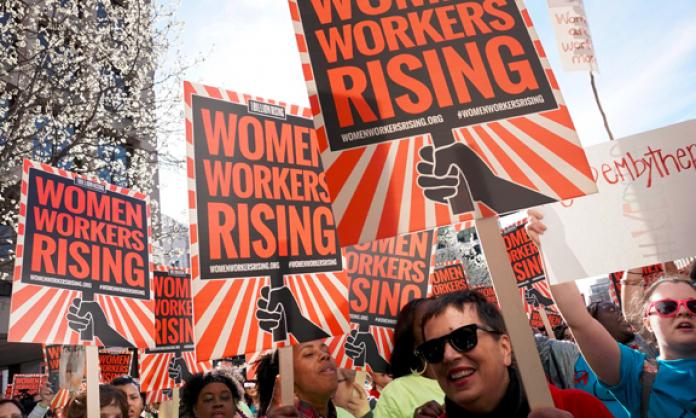The anti-Trump Women’s Marches in the US on 21 January were unprecedented. Three million women and men took to the streets across the country. It was a statement of intent: the coming period would be characterised by resistance and not passive resignation.
Protesters were angry not only at Trump’s vulgar sexism and threats to reproductive rights; the marches were vehicles for hatred of Trump’s entire agenda.
In the wake of the inauguration protests, a coalition of left wing activists and academics put out a call for an International Women’s Strike for 8 March. Their call was an explicit rejection of corporate feminism and its dominance in shaping the aims and language of the women’s movement.
“We do not want a world where women become CEOs, we want a world where there are no CEOs, and wealth is redistributed equally”, said Tithi Bhattacharya, a socialist and member of the strike organising committee. While a small number of women have climbed the corporate ladder, most women have been left behind. A statement issued by the strike committee pointed out:
“The attack on women (and all working people) long predates [Trump’s] administration. Women’s conditions of life, especially those of women of colour and of working, unemployed and migrant women, have steadily deteriorated over the last 30 years, thanks to financialisation and corporate globalisation.”
They aimed to build a “feminism for the 99 percent” by connecting the fight for women’s liberation with the broader struggles against the oppressive neoliberal order.
Building such a movement, organisers rightly argued, required independence from the Democrats, a party whose history is just as synonymous with ruling in the interests of Wall Street and the Pentagon as the Republicans’. To this end, the rally platforms did not host Democrat politicians or celebrities. Instead, the voices of those marginalised by corporate feminism took centre stage.
Importantly, they aimed to popularise the idea of the strike as a key weapon in our arsenal: by withdrawing our labour, stopping the flow of profits, we can take on the corporate elite who have a vested interest in women’s oppression.
Right wing critics
The lead-up to International Women’s Day generated substantial discussion of the women’s strike. The pages of the New York Times and the Guardian, and of women’s magazines such as Elle and Glamour, were filled with debate. The organisers of the women’s strike gained a platform to critique corporate feminism. They talked about the radical socialist origins of International Women’s Day and the inspiring history of working class women leading the fight against both sexism and the broader social and economic conditions that lie at the root of women’s oppression.
Unsurprisingly, this unapologetically radical approach provoked a flurry of opposition.
One line of attack was to charge the women’s strike with alienating more conservative women. The organisers, according to this line of argument, should have focused on demands that relate to all women.
But police brutality is not a marginal question for Black women. The campaign to rip millions of undocumented migrants from their families is not a marginal question for Latinas. Nor is the fight for higher wages and more public housing a side issue for women attempting to escape domestic violence. These are all central to addressing the needs and desires of the majority of women.
The demand for an “anti-racist and anti-imperialist feminism” was also criticised – in particular, the stance organisers took in solidarity with the Palestinian struggle.
But anti-imperialism, far from being a side issue or unnecessarily divisive, is a vital component of building a women’s movement that stands against the corporate elite.
The US ruling class has cynically used “feminist” arguments about the oppression of women in the Middle East to justify a decade and a half of imperialist intervention, the real purpose of which has been to secure the interests of the rich and powerful in the US. A women’s movement that does not resist war and colonialism – including in Palestine – has no claim to be a genuine movement for human liberation.
The most sustained line of attack on the women’s strike was that it would be nothing but “a day without privileged women”. Writing in the Los Angeles Times, Meghan Daum argued: “Make no mistake, 8 March will mostly be a day without women who can afford to skip work and shuffle childcare and household duties to someone else”.
Continuing this theme, Maureen Shaw wrote in Quartz: “This feels very much like a protest of the privileged – and frankly, unrealistic” because “tens of millions of women have neither the benefits nor the flexibility to take the day off in protest”. In Australia, this argument was regurgitated by talking heads on Q&A during its International Women’s Day special.
Instead of “shouting about issues”, as Shaw derisively called it, her more “plausible” strategy for change involves “offering fact sheets, suggesting language for contacting elected officials and providing tips for effective lobbying”. This strategy dovetails with that of the Democrats and is designed to corral opposition into the suffocating arms of the upholders of the neoliberal order.
Despite their newfound concern for precarious working class women, most columnists denigrating the women’s strike had been uncritical cheerleaders for Hillary Clinton during the Democratic primaries – despite Clinton being widely recognised as the candidate of choice for the ruling class because of her long-standing commitment to preserving the unequal status quo.
Bernie Sanders, on the other hand, represented a threat to the privileged because of his support for universal health care, free college tuition and the “Fight for 15” – the national campaign to raise the minimum wage. All of these are vital demands for addressing the needs of working class women. Sanders’ defeat and Clinton’s victory, aided by the Democratic Party machine, was not a victory for all women, only the wealthiest.
Instead of relying on the likes of Clinton, working class women have been at the forefront of the fight to improve their living conditions. Think of the low-waged women in the fast food and retail industries leading the Fight for 15. Or take the city-wide teachers’ strikes over the past few years in Chicago, involving tens of thousands of women workers linking up their fight for a decent contract with the struggle against budget cuts and school closures being implemented by Democratic Party administrations.
The history of International Women’s Day is the story of the courage and sacrifices of the most downtrodden and oppressed women in their fight for justice. Privilege had nothing to do with it. In fact, the very conditions of exploitation and oppression drove women workers to resist, and risk their jobs, their safety and at times their lives.
Few in the United States remember that the 1908 protests in New York by thousands of garment workers for better pay, shorter working hours and the right to vote – and women immigration textile workers the following year challenging horrific sweatshop conditions – inspired the international socialist movement to mark 8 March as International Working Women’s Day.
An important first step
While there was no general shut down of industry, three school districts across the country – Alexandria, Prince George and Chapel-Hill – announced that they would cancel classes for the day because hundreds, and in some places more than 1,000 teachers requested to take the day off to participate in the day of action.
Thousands also attended protests elsewhere. In recent history, International Women’s Day in the US has rarely been marked by protest let alone strike action. So the protests are a positive development.
There is still a lot of work to do. The labour movement in the US is weak. Only 10 percent of the US workforce is unionised. This isn’t the fault of the radical left, but of the Democrat-aligned, tame-cat unionism that dominates the US labour movement.
Building resistance in the US to Trump and the entire neoliberal order responsible for the misery of millions clearly faces challenges. Not least of all the weakness of labour movement and the hegemony of the Democrats in the unions and NGOs.
Nonetheless, the women’s strike has done a great deal to revive the radical traditions of International Women’s Day in the US. It has helped popularise a radical argument to millions of people across the country – about the need to build resistance on an anti-capitalist basis, and that disruption, defiance and working class action are vital if we are to advance the interests of working class women.










